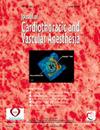The Use of Methadone and Ketamine for Intraoperative Pain Management in Cardiac Surgery: A Retrospective Cohort Study
IF 2.3
4区 医学
Q2 ANESTHESIOLOGY
Journal of cardiothoracic and vascular anesthesia
Pub Date : 2025-02-01
DOI:10.1053/j.jvca.2024.11.019
引用次数: 0
Abstract
Objectives
To evaluate whether the addition of ketamine to intraoperative methadone is associated with superior postoperative pain management and decreased opioid consumption compared with methadone alone in cardiac surgery patients.
Design
A retrospective cohort study.
Setting
A large academic medical system comprising four sites.
Participants
A total of 6,856 patients who underwent cardiac surgery with cardiopulmonary bypass and received intraoperative methadone between 2018 and 2023 were included. Patients were divided into two groups: those who received both methadone and ketamine (Group M+K; n = 5,696) and those who received methadone alone (Group M; n = 1,160).
Interventions
Intraoperative administration of methadone with or without ketamine. Some patients also received additional opioids such as hydromorphone and fentanyl.
Measurements and Main Results
The primary outcomes were daily total oral morphine equivalents (OMEs) until postoperative day (POD) 7 and the time to first postoperative opioid administration. The secondary outcome was daily postoperative pain scores until POD 7. Exploratory outcomes included delirium and intensive care unit length of stay. The median time to first postoperative opioid administration was longer in Group M+K (7.2 hours) compared with Group M (5.0 hours) (hazard ratio = 0.88, 95% confidence interval: [0.82, 0.95]). Total OMEs were significantly lower in Group M+K on POD 0 (ß = –2.24; 95% confidence interval: [–3.2, –1.3]), with no significant differences beyond POD 0. No significant differences were found in pain scores or exploratory outcomes.
Conclusions
Adding ketamine to methadone prolonged the time to first opioid consumption postoperatively but showed no benefits beyond POD 0. Future studies should consider protocolized dosing to optimize pain control.
在心脏手术中使用美沙酮和氯胺酮进行术中止痛:回顾性队列研究
目的:评价与单独使用美沙酮相比,在心脏手术患者术中加入氯胺酮是否与更好的术后疼痛管理和减少阿片类药物消耗有关。设计:回顾性队列研究。环境:一个由四个站点组成的大型学术医疗系统。参与者:在2018年至2023年期间,共有6856名接受心脏手术合并体外循环并术中接受美沙酮治疗的患者被纳入研究。患者分为两组:同时接受美沙酮和氯胺酮治疗的患者(M+K组;n = 5,696)和单独接受美沙酮治疗的患者(M组;N = 1160)。干预措施:术中给药美沙酮联合或不联合氯胺酮。一些患者还接受了额外的阿片类药物,如氢吗啡酮和芬太尼。测量和主要结果:主要结果为每日口服吗啡当量(OMEs)至术后第一天(POD) 7和术后第一次给药阿片类药物的时间。次要结局是术后每日疼痛评分,直到POD 7。探索性结果包括谵妄和重症监护病房的住院时间。与M组(5.0小时)相比,M+K组(7.2小时)至术后首次给予阿片类药物的中位时间更长(风险比= 0.88,95%可信区间:[0.82,0.95])。在POD 0上,M+K组总OMEs显著降低(ß = -2.24;95%置信区间:[-3.2,-1.3]),POD 0以上无显著差异。疼痛评分和探索性结果均无显著差异。结论:在美沙酮中加入氯胺酮延长了术后首次阿片类药物的使用时间,但没有超过POD 0的益处。未来的研究应考虑方案的剂量,以优化疼痛控制。
本文章由计算机程序翻译,如有差异,请以英文原文为准。
求助全文
约1分钟内获得全文
求助全文
来源期刊
CiteScore
4.80
自引率
17.90%
发文量
606
审稿时长
37 days
期刊介绍:
The Journal of Cardiothoracic and Vascular Anesthesia is primarily aimed at anesthesiologists who deal with patients undergoing cardiac, thoracic or vascular surgical procedures. JCVA features a multidisciplinary approach, with contributions from cardiac, vascular and thoracic surgeons, cardiologists, and other related specialists. Emphasis is placed on rapid publication of clinically relevant material.

 求助内容:
求助内容: 应助结果提醒方式:
应助结果提醒方式:


